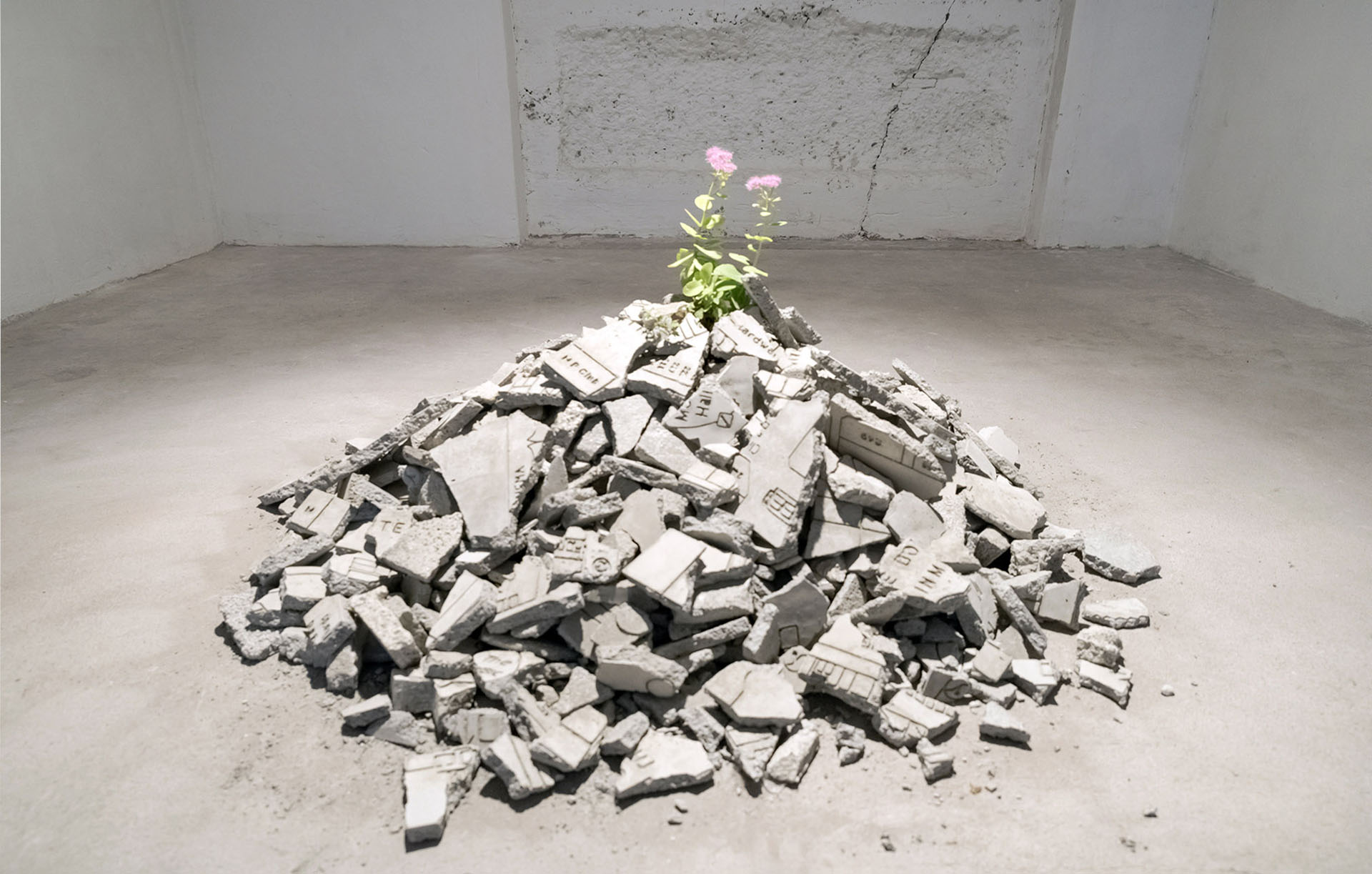
Performance of a Plant - 2013-15, variable measures fragment of art work and spontaneous plant, Collezione AGI - Verona
TEXT: For Andrea Francolino, fragments and rubble are correlatives of the idea of the vulnerability...
Artists of different generations and nationalities. Elisabeth Scherffig (Düsseldorf 1949) and Andrea Francolino (Bari 1979) share certain common denominators underlying their work: the interweaving of human activity and the flux of natural phenomena, a taxonomic interest and an investigation of the idea of historical and contemporary “landscape”. Both are devoted to an intensive flânerie, neither is adverse to using technology, from a digital camera to a GPS system, to capture visions, sensations, routes and traces. […]
[…]For Andrea Francolino, fragments and rubble are correlatives of the idea of the vulnerability and existential fragility of man and his works. In recent years, the artist has privileged the use of plaster and concrete, emblematic materials of the contemporary age, symbols of “progress” and considered to be durable and robust. Reflecting on the abuses of consumerism and materialism – with the relative consequences in ecological terms – Francolino has reproduced, destroyed and then reconstructed the plans of major shopping centres; using concrete dust he has instead “collected” the cracks in road surfaces encountered during his wanderings. The work Performance of a plant (2013-2015) is a heap of rubble composed of fragments of works destroyed and set aside. Out of these residues, deposited outside the artist’s studio while awaiting disposal, grew a spontaneous plant which the artist decided to safeguard and utilise for a new composition. Nature, in the midst of chance, poetry and life-force, has reaffirmed itself and has literally brought to life an abandoned, inert work.
Gaspare Luigi Marcone
Elisabeth Scherffig / Andrea Francolino, The Open Box, October 2015, Verona, curated by di Gaspare L.M.
Andrea Francolino, Performance of a plant, 2013-2015, remains of works in cement and concrete, spontaneous plant, varying dimensions.
[…]For Andrea Francolino, fragments and rubble are correlatives of the idea of the vulnerability and existential fragility of man and his works. In recent years, the artist has privileged the use of plaster and concrete, emblematic materials of the contemporary age, symbols of “progress” and considered to be durable and robust. Reflecting on the abuses of consumerism and materialism – with the relative consequences in ecological terms – Francolino has reproduced, destroyed and then reconstructed the plans of major shopping centres; using concrete dust he has instead “collected” the cracks in road surfaces encountered during his wanderings. The work Performance of a plant (2013-2015) is a heap of rubble composed of fragments of works destroyed and set aside. Out of these residues, deposited outside the artist’s studio while awaiting disposal, grew a spontaneous plant which the artist decided to safeguard and utilise for a new composition. Nature, in the midst of chance, poetry and life-force, has reaffirmed itself and has literally brought to life an abandoned, inert work.
Gaspare Luigi Marcone
Elisabeth Scherffig / Andrea Francolino, The Open Box, October 2015, Verona, curated by di Gaspare L.M.
Andrea Francolino, Performance of a plant, 2013-2015, remains of works in cement and concrete, spontaneous plant, varying dimensions.
TEXT: There is an objective awareness that man is mortal and cannot exist in eternity...
…E tu certo comprendi | il perché delle cose, e vedi il frutto | del mattin, della sera, | del tacito, infinito andar del tempo …
(Giacomo Leopardi, Canto notturno di un pastore errante dell'Asia)
[And you must understand | the ‘why’ of things, and view the fruits | of morning, evening, | silence, endless passing time… (Giacomo Leopardi, Night-Song Of A Wandering Shepherd of Asia)]
There is an objective awareness that man is mortal and cannot exist in eternity, thus experiencing the dichotomy between the fragility of his nature and the universality of his thought, unable to halt the relentless march of time: “Remember you are dust and to dust you will return.” And the symbol of this lies in two vases standing side by side: one with earth and chlorophyll, and its double with cement and steel rods. The biotic versus the abiotic. This dichotomy is the driving force behind the work of Andrea Francolino.
The evolution of man in his manifestations as a ‘cultural animal’, an animal which of all living beings influences nature so greatly, through forms of consumerism, materialism and hedonism, led the artist to question the sense of existence, of things and of art.
Following his investigation of mass manipulation and the analyses of contemporary consumerism, Francolino reaches an essential style, one apparently bereft of aesthetic structures, where the expressive vehicle becomes an inert and almost colourless material such as cement or concrete. Throughout the history of contemporary art – think of Consagra, Arte Povera, Uncini, Burri right up to the works by the minimalist Donald Judd, cement has become one of the expressive materials of art in its own right. After all, its violent impact, capable of transforming man-made landscapes throughout the world, moving them away from Nature, best typifies the parasitic action of man on the environment which has escalated in the post-modern era. A square metre of cement against one of fertile land are the emblem of the ambivalence of human economic transactions, a far cry from any genuine exchange of equivalent values.
Francolino dematerialises cement, stripping it of its monumental, imposing, glorious aspect, only to break it down into dust. As such it is an ephemeral material that flakes and disappears with a gust of wind. In particular, his study focuses on the crack. Thanks to this formless form, Francolino moves to a new level of maturity, one which allows him to unleash an ambivalence with a strong expressive character. The dichotomy thus takes shape. Indeed, while in his previous works, the clarity of his critical opinion with regard to man’s shifting away from nature was cumbersomely evident, now the artist steps back and remains in the shadows, letting the works lead the audience towards the existential questions from which he set out. For while the crack may have a negative connotation, one of fracture, fault, decay, corruption or fragility, it may also become a threshold, passage, access or opening. Like in the Japanese practice of Kintsugi, where the fracture in an object is soldered with gold dust, so as to underline its accidental peculiarity compared to serial standardisation, which the artist uses instead to ennoble the crack.
This highlights a Nature/Artifice dualism which has accompanied art ever since the period of Romanticism. Fractures highlighted through gold, and cracks from which spontaneous life pours forth, germinating: the empty side (the crack) which represents the sense of life, while the full side (the concrete) ponders the sense of things. A possible hint towards rebirth and the end, to the transformation of material returning to nature. Ultimately, the question is nothing more than the awareness of a toing and froing movement, i.e. a ‘From/To’, within which human existence oscillates. The ambivalence is also expressed in the artist’s practice, coupled with a performance approach to production, in which the number seven regulates the balance, for seven is the number of creation and of the seven wonders of the world. A research path leading beyond the studio, the ‘to’, in which the action of taking casts of cracks mimics the scientific and neutral work of the geologist, yet one which instead belongs to the wanderings of the flâneur in search of inspiration, who with a skilled hand armed with a burin, engraves the imprint on street level. The whole is completed by the demand for eternity gathered by the technological eye of the satellite – the ‘from’ – which embodies the avatar of the artist/astronomer, quite at ease in the post-modern era, moving towards science fiction. After all, as Francolino himself declares: “Looking at a crack is like looking at the universe: I reflect on the sense of life and of things.” And along that path of investigation, the crack leads to the places of art, rightly entering the interplay of ambivalences as explored by the artist, from the naturalness of creative human urgency to the artificial superstructure of the social accreditation system.
An articulated work that brings together sculptural materiality and rational calculation. Nature and Artifice, one oscillating within the other, like stones laid in the ground where the perception of what the mineral and chemical materials are may be misleading. It’s never what it looks like at first glance. And in this ambiguity, Francolino opens a crack, breaks down a wall to find the threshold of transformative germination, and to suggest another form of equilibrium in human existence, or at least a path towards it.
Neve Mazzoleni
[And you must understand | the ‘why’ of things, and view the fruits | of morning, evening, | silence, endless passing time… (Giacomo Leopardi, Night-Song Of A Wandering Shepherd of Asia)]
There is an objective awareness that man is mortal and cannot exist in eternity, thus experiencing the dichotomy between the fragility of his nature and the universality of his thought, unable to halt the relentless march of time: “Remember you are dust and to dust you will return.” And the symbol of this lies in two vases standing side by side: one with earth and chlorophyll, and its double with cement and steel rods. The biotic versus the abiotic. This dichotomy is the driving force behind the work of Andrea Francolino.
The evolution of man in his manifestations as a ‘cultural animal’, an animal which of all living beings influences nature so greatly, through forms of consumerism, materialism and hedonism, led the artist to question the sense of existence, of things and of art.
Following his investigation of mass manipulation and the analyses of contemporary consumerism, Francolino reaches an essential style, one apparently bereft of aesthetic structures, where the expressive vehicle becomes an inert and almost colourless material such as cement or concrete. Throughout the history of contemporary art – think of Consagra, Arte Povera, Uncini, Burri right up to the works by the minimalist Donald Judd, cement has become one of the expressive materials of art in its own right. After all, its violent impact, capable of transforming man-made landscapes throughout the world, moving them away from Nature, best typifies the parasitic action of man on the environment which has escalated in the post-modern era. A square metre of cement against one of fertile land are the emblem of the ambivalence of human economic transactions, a far cry from any genuine exchange of equivalent values.
Francolino dematerialises cement, stripping it of its monumental, imposing, glorious aspect, only to break it down into dust. As such it is an ephemeral material that flakes and disappears with a gust of wind. In particular, his study focuses on the crack. Thanks to this formless form, Francolino moves to a new level of maturity, one which allows him to unleash an ambivalence with a strong expressive character. The dichotomy thus takes shape. Indeed, while in his previous works, the clarity of his critical opinion with regard to man’s shifting away from nature was cumbersomely evident, now the artist steps back and remains in the shadows, letting the works lead the audience towards the existential questions from which he set out. For while the crack may have a negative connotation, one of fracture, fault, decay, corruption or fragility, it may also become a threshold, passage, access or opening. Like in the Japanese practice of Kintsugi, where the fracture in an object is soldered with gold dust, so as to underline its accidental peculiarity compared to serial standardisation, which the artist uses instead to ennoble the crack.
This highlights a Nature/Artifice dualism which has accompanied art ever since the period of Romanticism. Fractures highlighted through gold, and cracks from which spontaneous life pours forth, germinating: the empty side (the crack) which represents the sense of life, while the full side (the concrete) ponders the sense of things. A possible hint towards rebirth and the end, to the transformation of material returning to nature. Ultimately, the question is nothing more than the awareness of a toing and froing movement, i.e. a ‘From/To’, within which human existence oscillates. The ambivalence is also expressed in the artist’s practice, coupled with a performance approach to production, in which the number seven regulates the balance, for seven is the number of creation and of the seven wonders of the world. A research path leading beyond the studio, the ‘to’, in which the action of taking casts of cracks mimics the scientific and neutral work of the geologist, yet one which instead belongs to the wanderings of the flâneur in search of inspiration, who with a skilled hand armed with a burin, engraves the imprint on street level. The whole is completed by the demand for eternity gathered by the technological eye of the satellite – the ‘from’ – which embodies the avatar of the artist/astronomer, quite at ease in the post-modern era, moving towards science fiction. After all, as Francolino himself declares: “Looking at a crack is like looking at the universe: I reflect on the sense of life and of things.” And along that path of investigation, the crack leads to the places of art, rightly entering the interplay of ambivalences as explored by the artist, from the naturalness of creative human urgency to the artificial superstructure of the social accreditation system.
An articulated work that brings together sculptural materiality and rational calculation. Nature and Artifice, one oscillating within the other, like stones laid in the ground where the perception of what the mineral and chemical materials are may be misleading. It’s never what it looks like at first glance. And in this ambiguity, Francolino opens a crack, breaks down a wall to find the threshold of transformative germination, and to suggest another form of equilibrium in human existence, or at least a path towards it.
Neve Mazzoleni
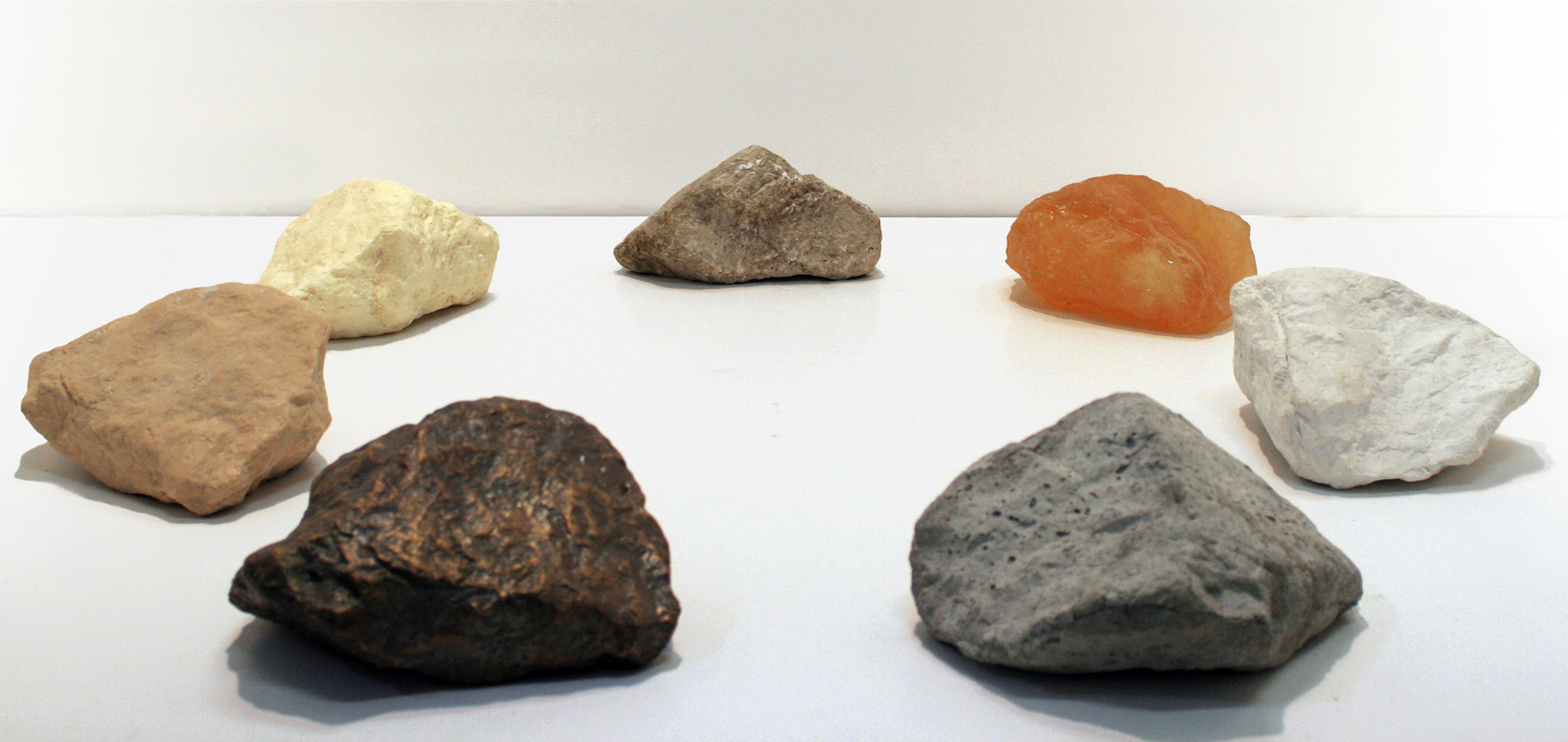
A-Biotic - 2016, 34x27x18cm, x 7 pieces rock bronze resin rubber gypsum polyurethane concrete
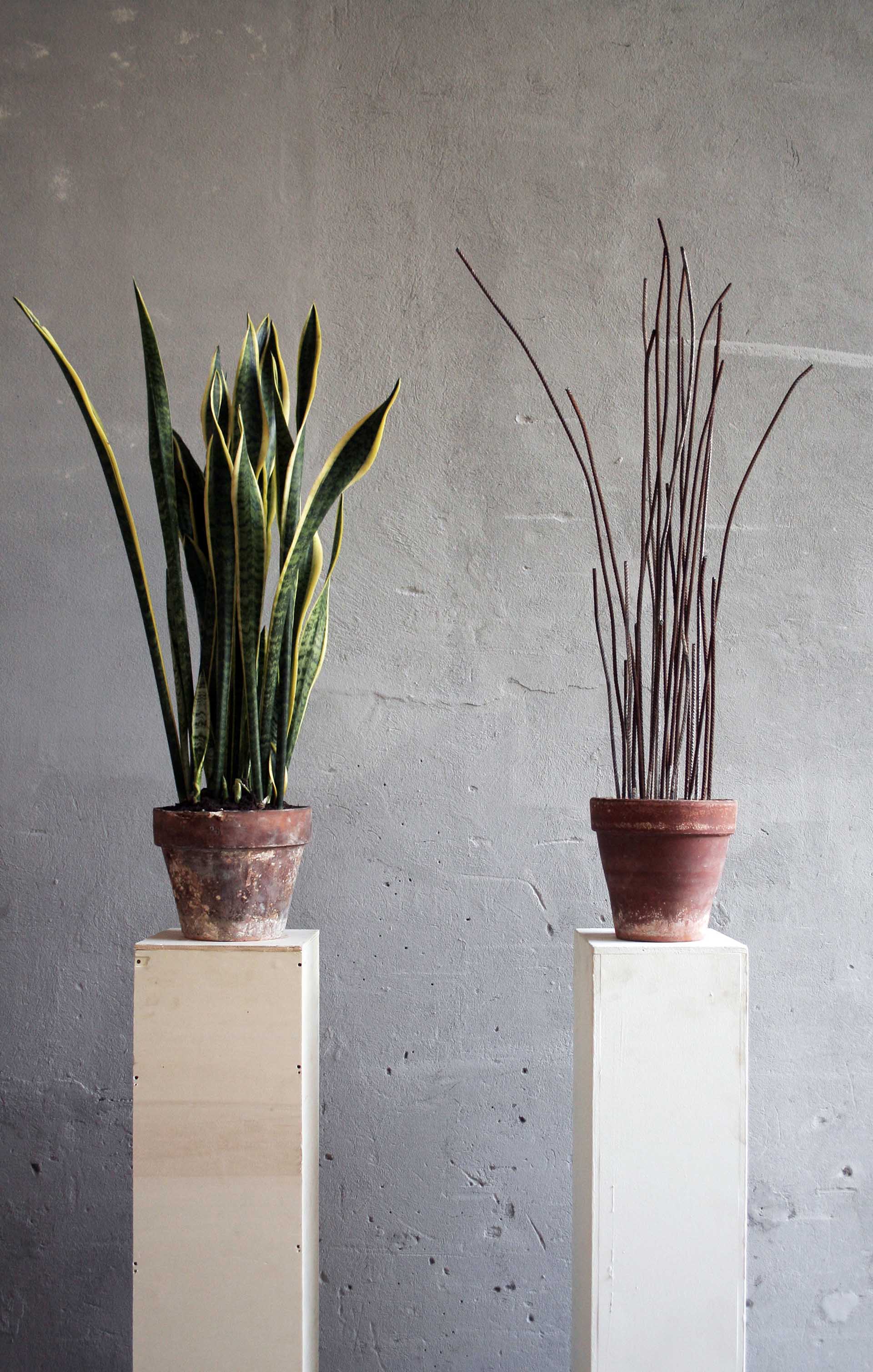
A-Biotic, vegetable plant reinforced concrete crock, 2015
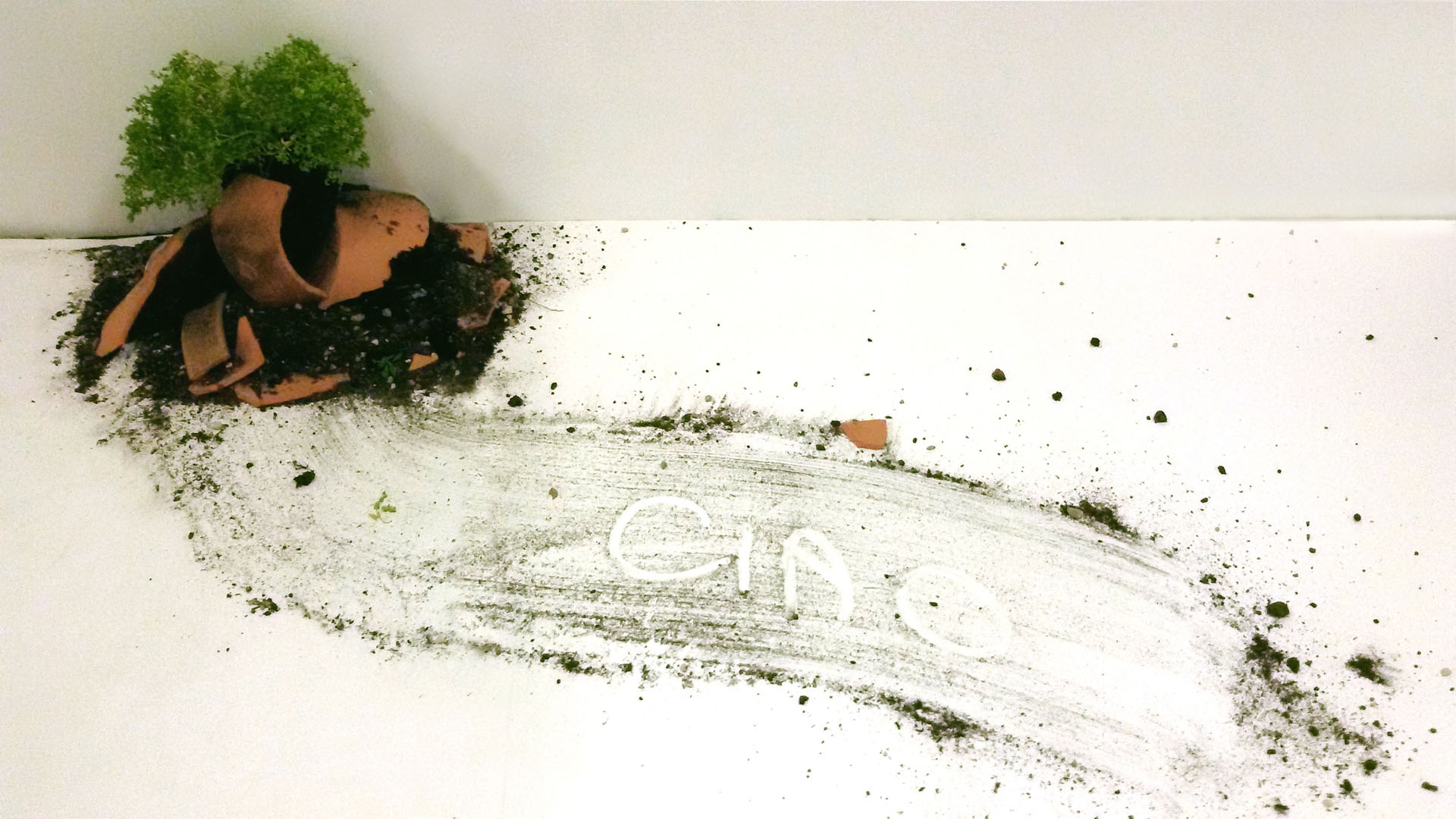
Mater - 2016, variable measures, crock fragment, soil and plant
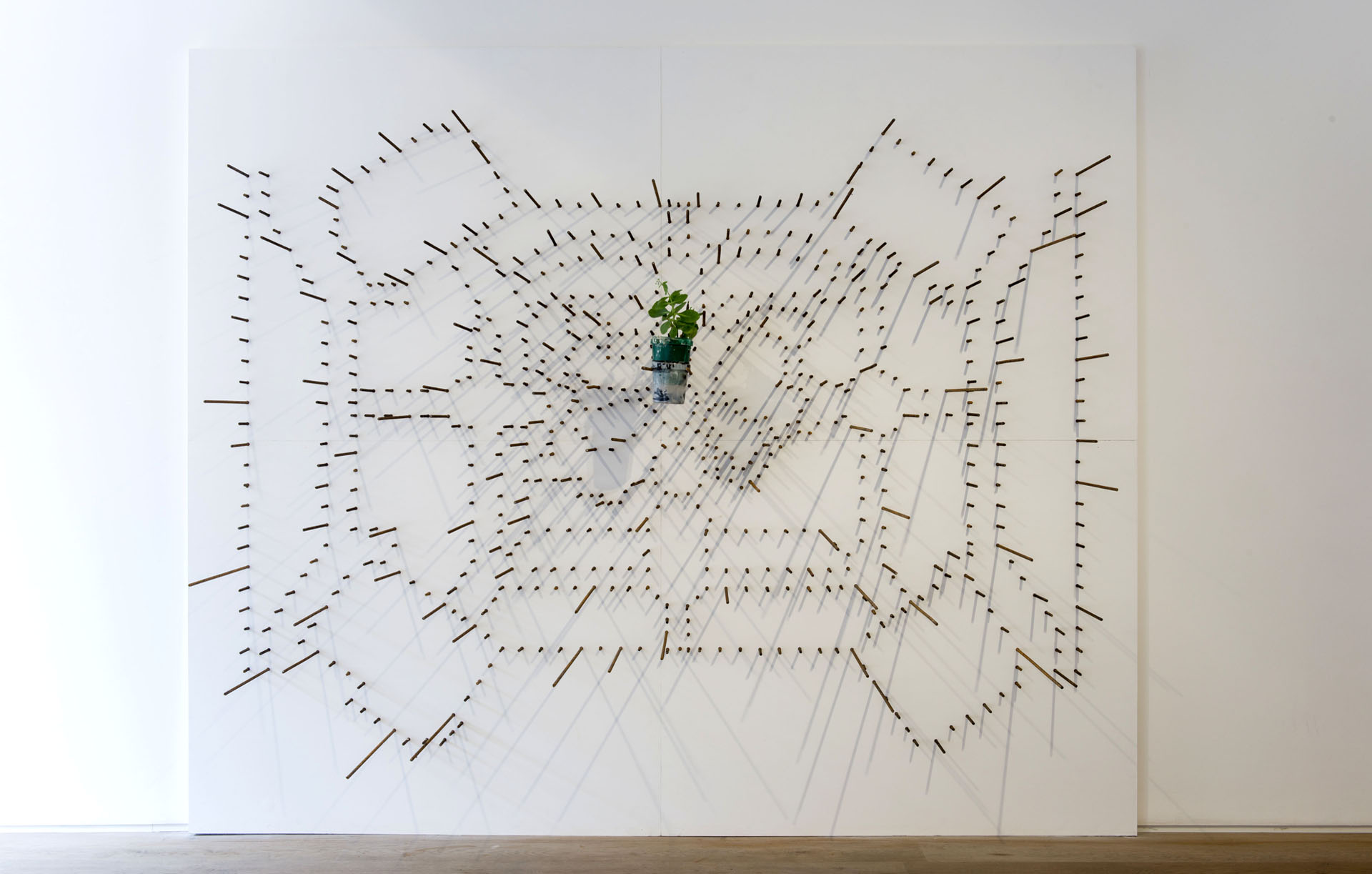
A-Biotic - 2014, 768 irons for reinforced concrete spontaneous plant, 225x270x90cm
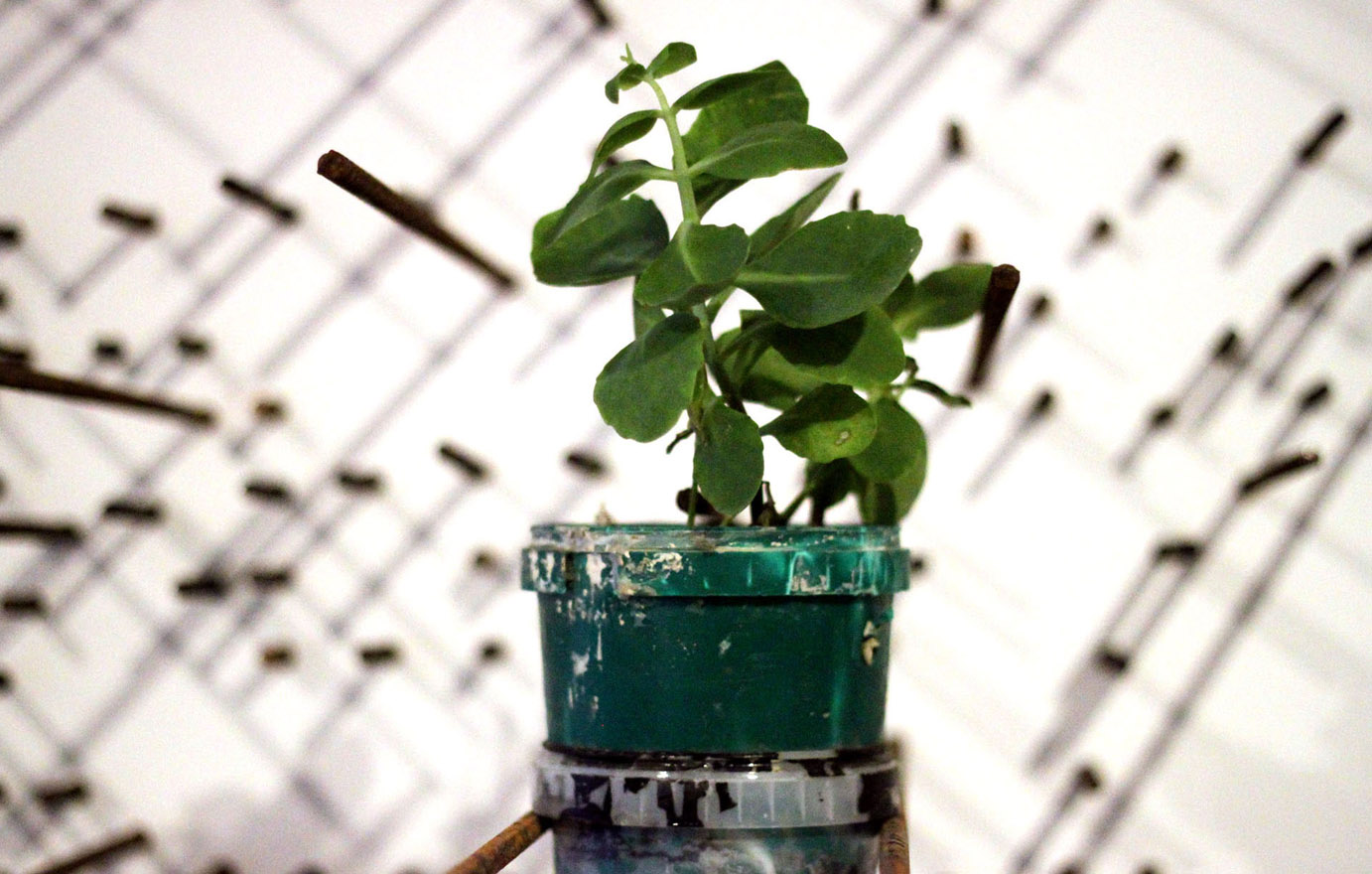
DETAIL: A-Biotic - 2014, 768 irons for reinforced concrete spontaneous plant, 225x270x90cm
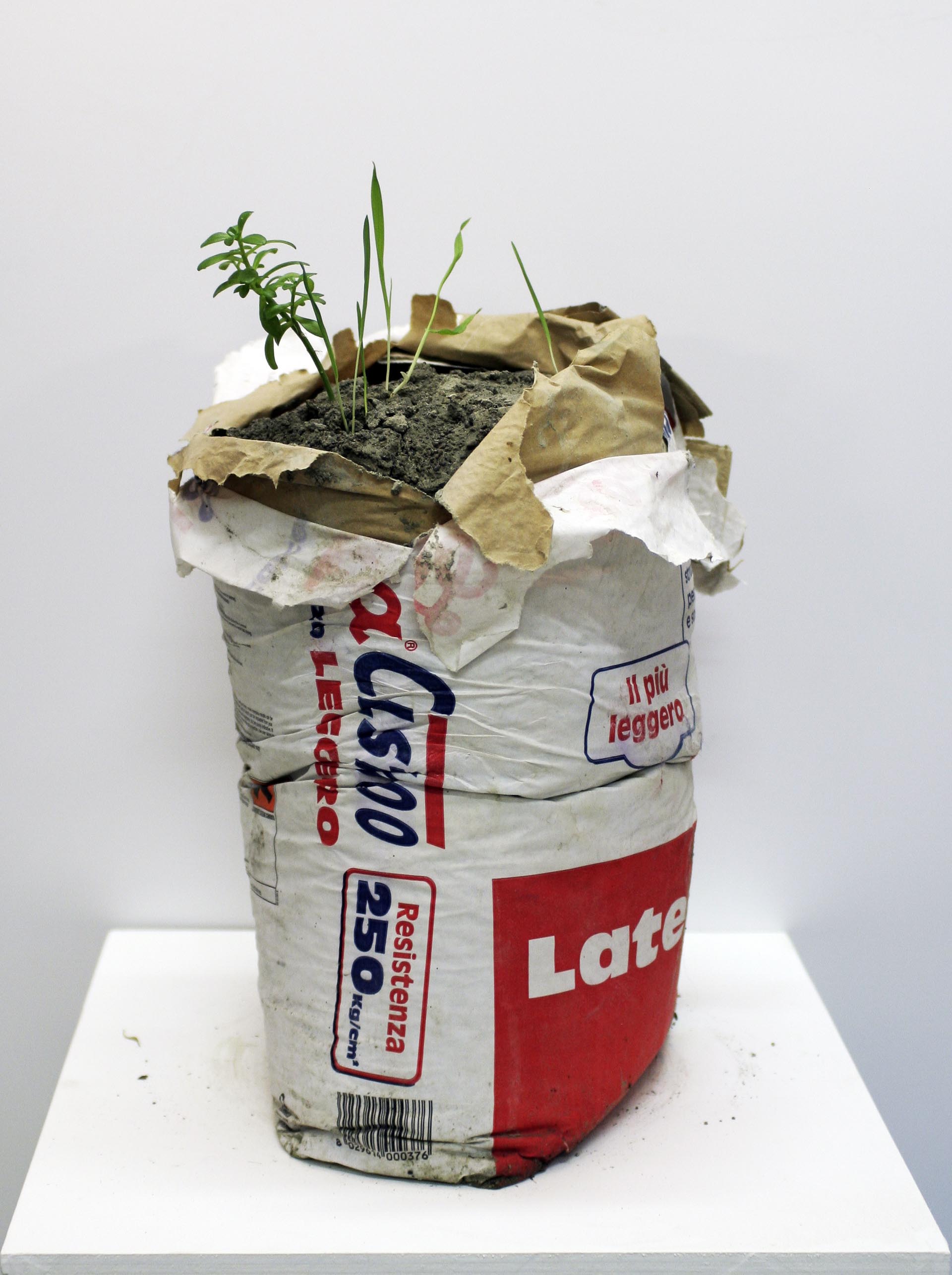
Performance of a plant - 2013, concrete bag and spontaneous plant
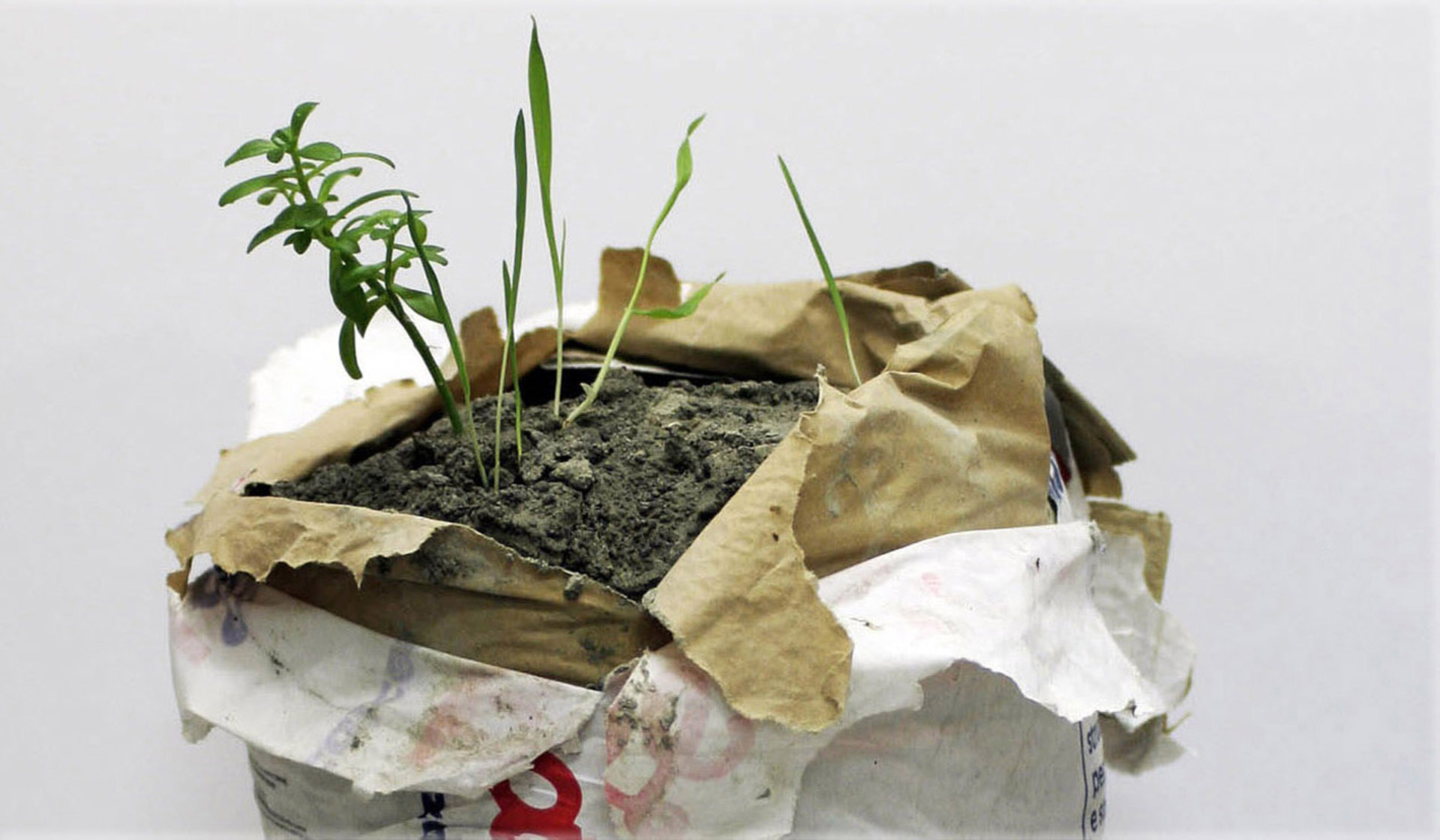
DETAIL: Performance of a plant - 2013, concrete bag and spontaneous plant

